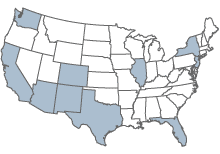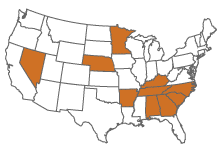Rogelio Saenz
Professor of Sociology, Texas A&M University

August 20, 2004
Professor of Sociology, Texas A&M University
The following edited excerpt is from the report Latinos and the Changing Face of America, written by Rogelio Saenz and published by the Russell Sage Foundation and Population Reference Bureau. This report is one of several in the new series The American People, which sets the results of Census 2000 in context and collectively provides a portrait of the American people in a new century. Each report is written by an author or team of authors selected for their expertise with the data and their broad understanding of the implications of demographic trends. Reynolds Farley and John Haaga are the series editors.
Over the last 100 years, few racial or ethnic groups have had as great an impact on the demography of the United States as Latinos. In 1900, there were only slightly more than 500,000 Latinos.1 Today, the national Latino population numbers more than 35 million and represents one of the most dynamic and diverse racial/ethnic groups in the United States.
The most dramatic impact of the Latino population on the demography of the nation has taken place over the last few decades. The number of Latinos in the United States more than doubled between 1980 and 2000, accounting for 40 percent of the growth in the country’s population during that period. And in 2003 the U.S. Census Bureau designated Latinos as the nation’s largest minority group, an amazing event given that in 1980 the Latino population was only slightly more than half the size of the African American population.
The Latino population has had an impact not only on the demography of the U.S. population, but also on other aspects of U.S. society. This can be seen, for example, in the increasing popularity of Latin American food and music and in the prevalence of Spanish-language signage, advertisements, and media. In addition, the business community has discovered the economic clout of the Latino population.
The increase in buying power of the Latino population over this 18-year period is expected to be greater than that of the white, African American, American Indian, and Asian populations. Politicians increasingly recognize the political muscle of the Latino population, especially with the group’s concentration in the most populous states in the nation.
Their great diversity presents challenges in understanding the rate and extent of Latino groups’ integration into mainstream U.S. society. Educators, policymakers, businesspeople, and others in the United States require knowledge about the Latino population and the groups within it to more effectively understand and serve the particular needs of Latino populations. This is particularly true now that the Latino population has expanded geographically beyond its traditional hub areas into places that have historically had few Latinos.
During the 1990s, the Latino population marked its dominance as the ethnic group most responsible for population growth in the United States. The Latino population expanded from 22.4 million in 1990 to 35.3 million in 2000, a growth rate of 58 percent (see Table 1).
| Group | 1990 | 2000 | Change 1990-2000 |
% change 1990-2000 |
|---|---|---|---|---|
| Total U.S. population | 248,709,873 | 281,421,906 | 32,712,033 | 13.2 |
| Latino | 22,354,059 | 35,305,818 | 12,951,759 | 57.9 |
| Mexican | 13,495,938 | 20,640,711 | 7,144,773 | 52.9 |
| Puerto Rican | 2,727,754 | 3,406,178 | 678,424 | 24.9 |
| Cuban | 1,043,932 | 1,241,685 | 197,753 | 18.9 |
| Other Latino | 5,086,435 | 10,017,244 | 4,930,809 | 96.9 |
| Non-Latino* | 226,355,814 | 246,116,088 | 19,760,274 | 8.7 |
| White | 188,128,296 | 194,552,774 | 6,424,478 | 3.4 |
| African American | 29,216,293 | 33,947,837 | 4,731,544 | 16.2 |
| American Indian & Alaska Native | 1,793,773 | 2,068,883 | 275,110 | 15.3 |
| Asian & Pacific Islander | 6,968,359 | 10,476,678 | 3,508,319 | 50.3 |
| Other race | 249,093 | 467,770 | 218,677 | 87.8 |
* Non-Latino groups are single-race groups.
Sources: Author’s estimates using Census 1990 Summary Tape File 1 (STF1) and Census 2000 Summary File 1 (SF1).
The growth rate of the Latino population was nearly 4.5 times greater than that of the total U.S. population and more than six times that of the non-Latino population in the country. By 2000 Latinos accounted for one in eight people in the United States, compared with one in 11 people in 1990.
The Latino population is concentrated in particular states. The 10 states with the largest Latino populations in 2000 were home to slightly more than 80 percent of U.S. Latinos (see Figure 1). These states represent traditional hub areas for Latinos, with all but one (Washington) being among the top-10 most populous Latino states in 1990 as well. California and Texas alone accounted for one of every two Latinos in the United States.

Sources: Author’s estimates using Census 1990 Summary Tape File 1 (STF1) and Census 2000 Summary File 1 (SF1).

Sources: Author’s estimates using Census 1990 Summary Tape File 1(STF1) and Census 2000 Summary File 1 (SF1).
The Latino population has grown quite rapidly in states that have traditionally had relatively few Latinos (see Figure 2). Among the 10 states with the most rapid growth in the Latino population, the percentage increases ranged from a low of 155 percent in Nebraska to 394 percent in North Carolina. This growth has primarily been associated with the restructuring of the meat-processing industry and the expansion of low-wage jobs in the South and the Midwest,2 primarily in nonmetropolitan areas.3
Nevada stands apart from the other nine states. Drawn by a dynamic economy dominated by service jobs and the gaming industry, Nevada’s Latino population tripled between 1990 and 2000.
Over the last several decades, the racial and ethnic composition of the U.S. population has changed markedly. Minorities are increasing their presence in the United States and will continue to do so for the foreseeable future. The Latino population is driving these transformations. While today one of every eight residents of the United States is Latino, it is projected that Latinos could account for one of every five residents by 2035, one of every four by 2055, and one of every three by 2100.
Latinos are already having a significant impact on the various societal institutions and on all segments of society in the United States. Although Latinos represented hardly a blip on the national radar screen only a few decades ago, demographic processes have made Latinos critical to the future social and economic direction of the United States.
Ongoing immigration has significantly affected the Latino experience in the United States. The continued flows of Latino immigrants ensure that the Spanish language and diverse Latino cultures will endure in the United States. The combination of established and newcomer Latinos in the United States further enhances the diversity that exists across and within Latino groups.
The growth of the Latino population has also led to a blurring of many boundaries. Transnational migration has blurred international and identity boundaries. Immigration has blurred the boundaries associated with nativity, even within families. The increasing use of Spanish through its dominance in foreign-language instruction in colleges and universities, its entrance into mainstream popular culture, and the bilingual context in which many Latinos operate have also blurred language boundaries.
But the experiences of the various Latino groups in the United States have been quite different, and even the blurring of place and linguistic boundaries has not eliminated one important distinction. Mexicans and Puerto Ricans are the two groups that were initially incorporated into the United States through warfare. They have been viewed as “colonized groups.”4 Throughout their long history in the United States, Mexicans and Puerto Ricans have occupied a low position in the nation’s social and economic hierarchy. Even U.S.-born Mexicans and mainland-born Puerto Ricans occupy a low socioeconomic position among the various groups that constitute the Latino population.
In contrast, other Latino groups have come to the United States as voluntary immigrants, either escaping political persecution or in search of economic opportunity. By and large, these groups have tended to fare better socially and economically, the exception being Dominicans and foreign-born Central Americans.
The Latino population needs to be seen as a valuable resource for this country. U.S. institutions will increasingly be affected by and dependent on Latinos in the coming decades. For example, the business community will increasingly rely on Latinos as entrepreneurs, employees, investors, and consumers. The bilingual and bicultural nature of the Latino population also makes Latinos a valuable resource as the U.S. business community expands its consumer markets and business operations into Latin America.
The higher education system will increasingly find Latinos among the ranks of potential students and educators. Political institutions will find that Latinos will play an increasingly powerful role in the outcome of elections, both as voters and as political candidates. Additionally, the health care system will increasingly see Latinos as health care recipients and providers. Religious institutions will find that their potential adherents and leaders will increasingly be Latinos.
These trends are well underway in the largest states and at the national level; the rising dispersion of Latinos into parts of the country that traditionally have not had Latino populations suggests that all parts of the country will feel the impact of Latino growth.
Rogelio Saenz is professor and head of the department of sociology at Texas A&M University. He is the author of numerous journal articles, book chapters, and technical reports on the demography of Latinos, immigration, social inequality, and race and ethnicity.
